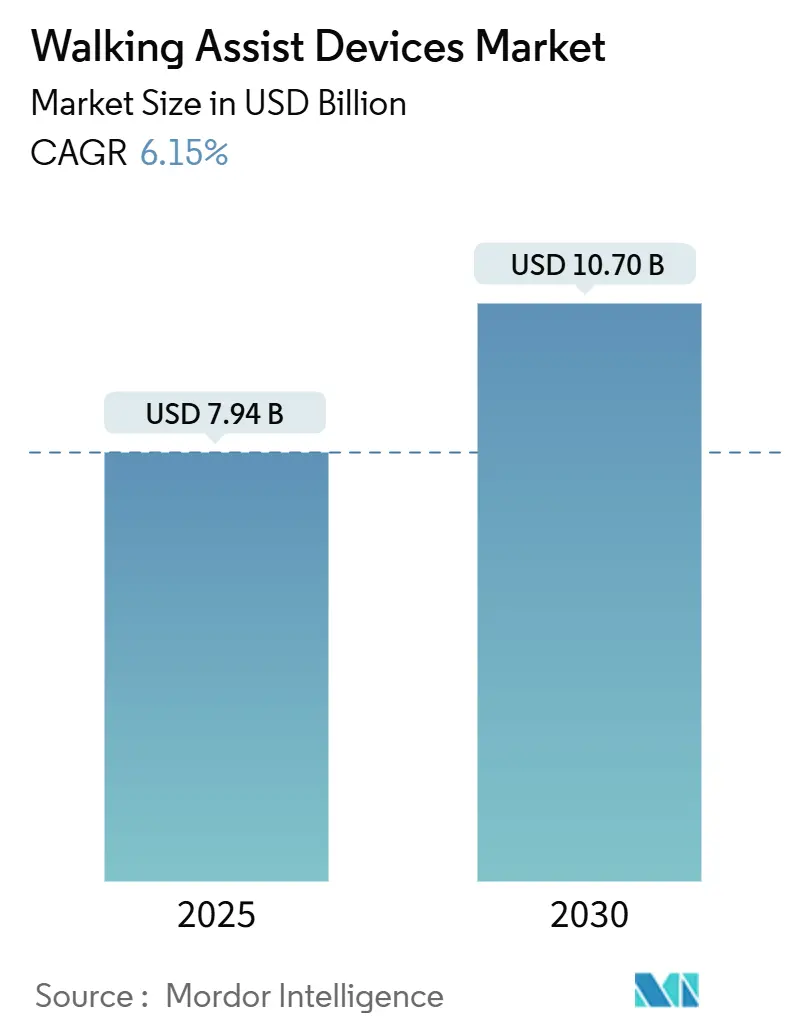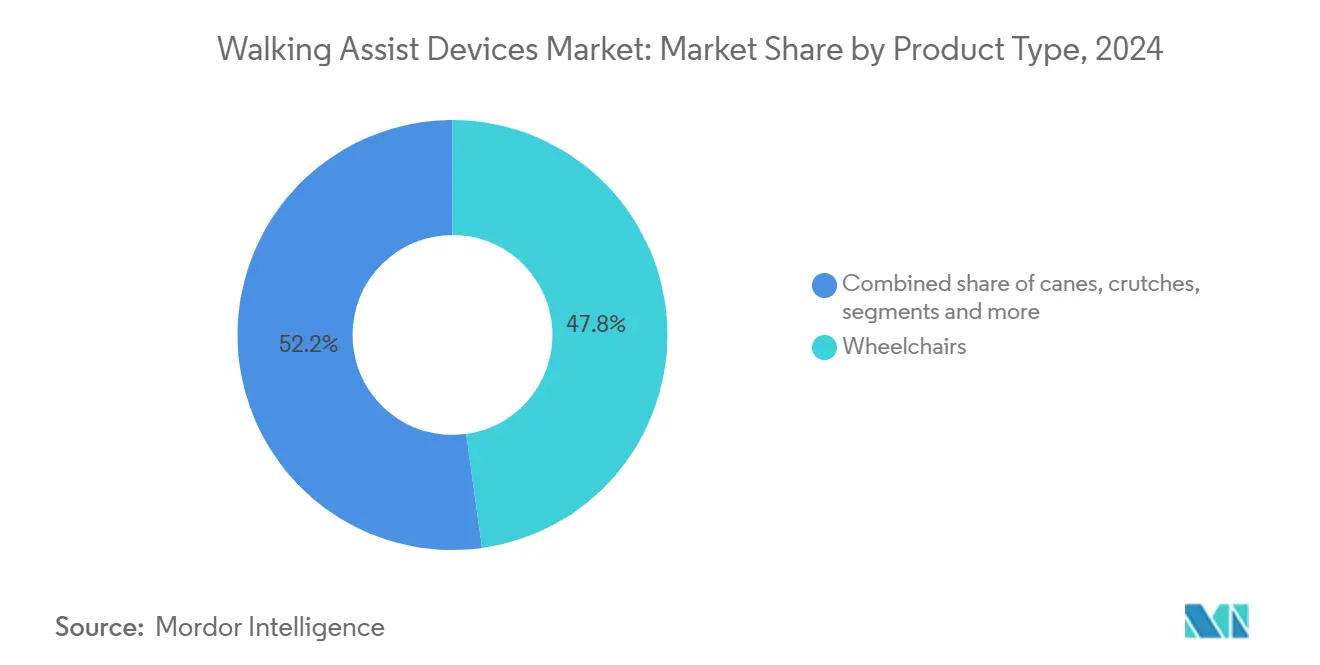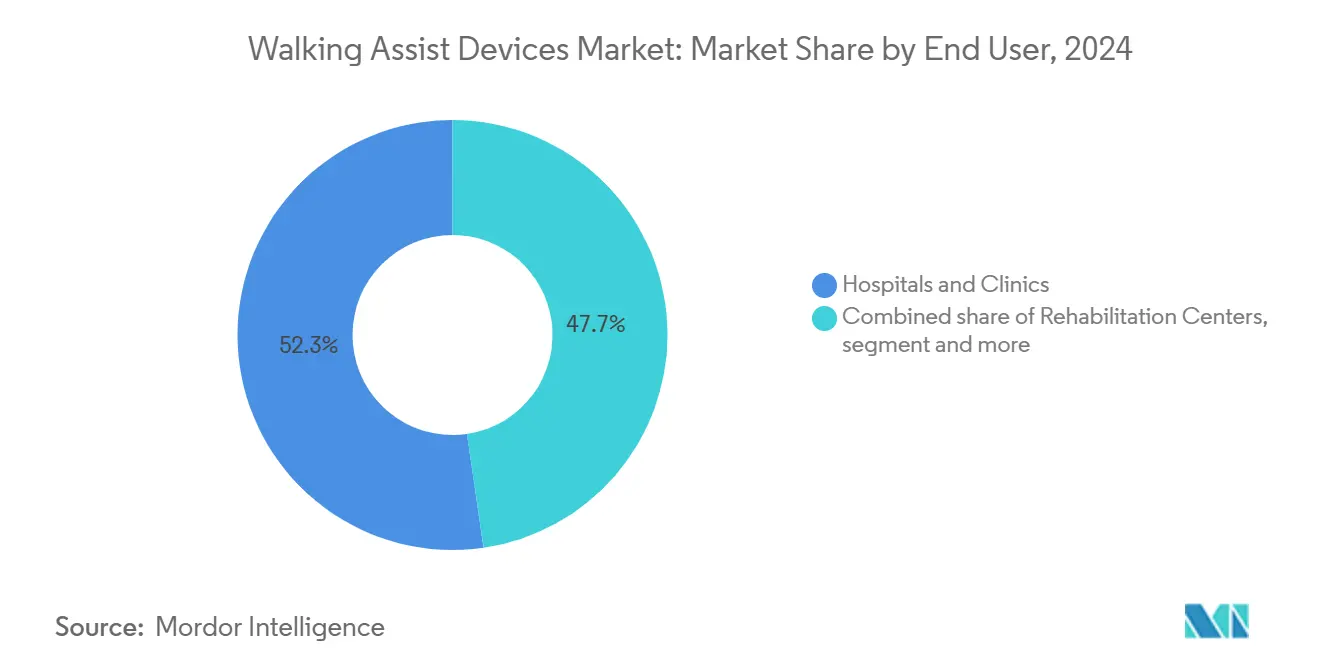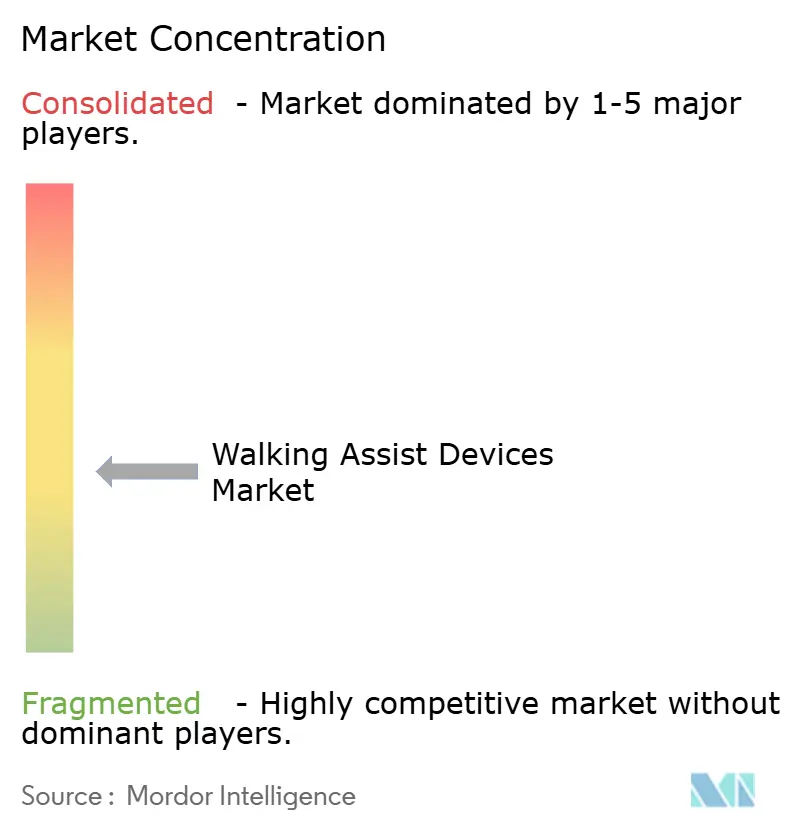Walking Assist Devices Market Size and Share

Walking Assist Devices Market Analysis by Mordor Intelligence
The walking assist devices market is valued at USD 7.94 billion in 2025 and is forecast to reach USD 10.70 billion in 2030, advancing at a 6.15% CAGR. Demand is shifting from purely clinical equipment toward solutions that restore autonomy, drawing investment from consumer electronics, automotive and insurance sectors. Population aging, the osteoarthritis burden, and rising survivorship after major surgery steadily lift baseline volumes, while smart sensors, lightweight materials and connectivity expand the functional range of devices. Competitive intensity is growing as incumbents acquire niche innovators, but regulatory amendments on quality and cybersecurity are likely to reshape cost structures. Taken together, these forces position the walking assist devices market for steady, technology-led growth while keeping entry barriers high for low-cost replicas.
Key Report Takeaways
- By product type, wheelchairs led with 47.79% revenue share in 2024, whereas gait belts and lift vests are projected to grow at a 7.26% CAGR to 2030.
- By technology, manual assist devices accounted for 56.87% of the 2024 walking assist devices market share; smart sensor-enabled devices are expanding at 8.12% CAGR through 2030.
- By end user, hospitals and clinics held 52.32% of the 2024 walking assist devices market size, while home-care settings are forecast to rise at 7.91% CAGR to 2030.
- By distribution channel, pharmacy and retail outlets captured 64.28% share in 2024; e-commerce platforms are advancing at 8.26% CAGR through 2030.
- By geography, North America represented 40.74% of global revenue in 2024, whereas Asia-Pacific is set to post the fastest 8.64% CAGR to 2030.
Global Walking Assist Devices Market Trends and Insights
Drivers Impact Analysis
| Driver | (~) % Impact on CAGR Forecast | Geographic Relevance | Impact Timeline |
|---|---|---|---|
| Accelerating prevalence of osteoarthritis & rheumatoid arthritis | +1.8% | Global, with highest impact in North America & Europe | Long term (≥ 4 years) |
| Rising demand for post-operative rehabilitation equipment | +1.2% | Global, concentrated in developed healthcare systems | Medium term (2-4 years) |
| Rapidly expanding geriatric population base | +1.5% | Asia-Pacific core, spill-over to North America | Long term (≥ 4 years) |
| Increasing fall-related injuries prompting preventive walking aids | +0.9% | Global, with emphasis on developed economies | Medium term (2-4 years) |
| Commercialization of AI-enabled smart canes & sensor walkers | +0.7% | North America & EU early adoption, Asia-Pacific scaling | Short term (≤ 2 years) |
| Growth in long-COVID–linked mobility impairments | +0.6% | Global, with regional variation based on infection rates | Short term (≤ 2 years) |
| Source: Mordor Intelligence | |||
Accelerating prevalence of osteoarthritis & rheumatoid arthritis
The osteoarthritis burden is rising in tandem with obesity and sedentary lifestyles. In the United States, 32.5 million people live with osteoarthritis and direct medical costs reach USD 65 billion annually. Global prevalence now exceeds 606 million cases, and incidence climbs sharply after age 55, making assistive devices a routine component of long-term care. Rheumatoid arthritis follows a similar pattern, with 2024 data confirming smoking as a causal risk factor and showing higher rates among women in high socio-demographic regions. These trends sustain demand for wheelchairs, walkers and joint-offloading solutions.
Rising demand for post-operative rehabilitation equipment
Elective joint‐replacement volumes rebounded in 2024, and hybrid telerehabilitation programmes now support outpatient recovery pathways. Continuous-passive-motion devices, sensorised walkers and lightweight wheelchairs allow earlier discharge and reduce readmission risk. Neuromuscular electrical stimulation is increasingly embedded in walkers to counter ICU-acquired weakness.[1]Journal of Rehabilitation Medicine, “Post-COVID Neuromuscular Recovery,” jrm.medicaljournals.se
Rapidly expanding geriatric population base
Asia-Pacific will host 1.3 billion people over 60 years by 2050, equal to 25% of its total population. Worker-to-senior ratios are dropping to 2.4:1 in Japan and 4:1 in Singapore, creating care-delivery gaps that community-grade mobility aids help to close. Forty percent of older adults in the region lack pension coverage, prompting extended workforce participation that requires durable, occupationally acceptable devices.
Commercialization of AI-enabled smart canes & sensor walkers
The WeWalk Smart Cane 2.0 launched at CES 2025 integrates lidar-based obstacle detection, haptic feedback and Bluetooth mapping, turning a basic cane into a navigation appliance. Wheelchairs with detachable two-way propulsion allow both push and pull strokes, reducing shoulder load and doubling as exercise platforms.[2]Sensors MDPI, “Monit4Healthy: An IoT-Based Remote-Care System,” mdpi.com
Restraints Impact Analysis
| Restraint | (~) % Impact on CAGR Forecast | Geographic Relevance | Impact Timeline |
|---|---|---|---|
| High acquisition & maintenance costs of powered devices | -1.4% | Global, with acute impact in developing economies | Medium term (2-4 years) |
| Limited reimbursement coverage in developing nations | -0.8% | Asia-Pacific, Latin America, Africa | Long term (≥ 4 years) |
| Product recalls due to safety / stability issues | -0.6% | Global, with regulatory focus in North America & EU | Short term (≤ 2 years) |
| Cyber-security & data-privacy risks in connected mobility aids | -0.4% | Global, concentrated in developed markets with high connectivity | Medium term (2-4 years) |
| Source: Mordor Intelligence | |||
High acquisition & maintenance costs of powered devices
Entry-level powered wheelchairs such as the WHILL Model Ci retail for USD 4,999, out of reach for many patients. Lithium-ion battery packs require replacement every five to seven years, adding up to 40% of initial cost. Recent recalls, including 781 SmartDrive units linked to unintended motor activation, underline the need for rigorous quality control. Such incidents amplify cost concerns by elevating insurance premiums and service fees.
Limited reimbursement coverage in developing nations
Many emerging economies fund only basic crutches or walkers, leaving advanced devices to out-of-pocket spending. Where coverage exists, reimbursement ceilings rarely match retail prices, creating grey markets for refurbished equipment. China’s 18% medical-device growth rate signals latent potential, yet insurance frameworks lag behind demographic need.
Segment Analysis
By Product Type: Wheelchairs Retain Scale, Gait Belts Lead Growth
Wheelchairs held 47.79% of global revenue in 2024, confirming their central role in both acute and long-term settings. Manual models dominate today, but powered and smart variants are entering mainstream procurement as battery prices fall. Gait belts, lift vests and related transfer aids are projected to outpace other categories at 7.26% CAGR. Their rise reflects stricter worker-safety rules and the push to minimize caregiver injuries.
Regulatory clarity sustains baseline wheelchair demand, given their Class I or Class II designation under FDA and CE rules. Innovations such as the detachable two-way propulsion system improve ergonomics and widen use cases, keeping the walking assist devices market dynamic. Meanwhile, fall-prevention devices for Parkinson’s and post-stroke patients are blurring traditional boundaries, hinting at convergence with wearable technologies.

Note: Segment shares of all individual segments available upon report purchase
By Technology: Manual Reliability Meets Smart Expansion
The walking assist devices market size for manual devices remains the largest, yet smart sensor platforms are registering the fastest gains. Manual chairs, crutches and walkers are affordable, need no charging and carry minimal cyber-risk, explaining their 56.87% share in 2024. Smart devices, posting 8.12% CAGR, embed lidar, pressure sensors and real-time analytics to warn of obstacles or monitor vital signs. Powered chairs occupy a middle ground, benefiting from battery innovations and clearer test standards.
The Internet of Medical Things enables continuous monitoring through cloud dashboards, allowing clinicians to adjust therapy remotely. Still, cyber-security adds cost and complexity; FDA now requires software bills of materials and post-market patching plans for connected aids. In practice, users choose along a spectrum of price, maintenance capacity and information-sharing comfort.
By End User: Hospitals Command Volume, Home Care Scales Fast
Hospitals and clinics represented 52.32% of 2024 demand, as they remain the first distribution node for mobility prescriptions. Ageing in place, however, is spurring a 7.91% CAGR in home-care uptake. Families prefer shorter inpatient stays and remote follow-up, putting a premium on foldable wheelchairs, adjustable walkers and devices that stand up to everyday use without on-site technicians.
Rehabilitation Centers see rising admissions of long-COVID and elective-surgery patients who need transitional aids. Elderly-care facilities in Japan, Germany and Italy face staffing shortages, prompting bulk purchases of easy-to-clean transfer belts and powered lifts. The walking assist devices market demonstrates that one device often migrates across settings during its lifecycle, so manufacturers now design for multi-environment performance.

Note: Segment shares of all individual segments available upon report purchase
By Distribution Channel: Brick-and-Mortar Dominates, E-commerce Widens Access
Pharmacies and retail stores own 64.28% of global sales because urgent needs and professional fitting still drive most purchases. E-commerce, advancing at 8.26% CAGR, bridges gaps for rural buyers and enables direct-to-consumer price transparency. High-value powered chairs and customised seating continue to flow through specialist dealers that offer measuring services and financing plans.
Omnichannel strategies are emerging. WHILL and Scootaround, for example, combine online rentals with airport pick-up, illustrating how service layers augment product sales. Stronger regulatory oversight of online vendors is expected as authorities tighten traceability rules, which may favour established healthcare retailers entering the digital arena.
Geography Analysis
North America accounted for 40.74% of global revenue in 2024, anchored by robust insurance coverage and established clinical pathways. The region benefits from new FDA Quality System amendments effective in 2026, which simplify post-market surveillance and align supplier audits. Yet high list prices for powered chairs and complex coding for reimbursement can delay adoption. The recent USD 13.5 million settlement involving improper Medicare claims underscores ongoing billing scrutiny. Canada’s assistive-device programmes and Mexico’s growing private insurance sector add depth to regional demand.
Asia-Pacific is projected to deliver an 8.64% CAGR to 2030, the fastest worldwide. Demographic momentum, with the 80+ cohort quadrupling between 2016 and 2050[3]United Nations Economic and Social Commission for Asia and the Pacific, “Ageing in Asia-Pacific,” unescap.org, intersects with urban-density challenges that favour compact, lightweight aids. Japan’s long-term-care insurance reimburses high-end wheelchairs, while China’s domestic manufacturers scale up powered scooter lines for export. Approximately 40% of seniors lack pension coverage, making affordability essential; as a result, rental programmes and refurbished equipment exchanges are proliferating.
Europe maintains steady growth backed by universal healthcare and harmonised CE marking requirements. Germany and France drive volume through statutory insurance, whereas the United Kingdom adjusts post-Brexit conformity protocols. Sunrise Medical, headquartered in Germany, leverages in-region manufacturing and recent acquisitions such as Ride Designs to broaden its seating portfolio. The Medical Device Regulation (EU) 2017/745 imposes more stringent clinical evidence and post-market vigilance, benefiting suppliers with strong QA systems.

Competitive Landscape
The walking assist devices market shows moderate fragmentation: the top brands together hold a significant global share, yet consolidation is underway. Sunrise Medical posted EUR 636 million revenue in 2023 after adding Ride Designs and pediatric specialist Leckey to its stable, highlighting a build-and-integrate strategy. Permobil and Max Mobility focus on powered solutions but faced quality setbacks following the SmartDrive recall, prompting fresh investment in risk-engineering systems.
Invacare’s North American business was acquired by MIGA Holdings in late 2024, securing capital for R&D while streamlining supply chains. Meanwhile, AI-centric newcomers such as WeWalk target niche user groups, relying on collaborative manufacturing and cloud-based feature updates. Contract manufacturers in Vietnam and Mexico gain share as OEMs re-shore away from single-country exposure, especially for aluminum frames and lithium-battery packs.
Intellectual-property filings reveal priorities: Sunrise Medical’s spherical-joint back supports enhance seating ergonomics, while Permobil’s drive-assist algorithms aim at curb climbing and hill descent. To defend margins, leading brands bundle extended-warranty service, IoT dashboards, and financing schemes, turning devices into subscription-ready platforms. Smaller regional firms concentrate on cost-optimized manual chairs and walkers, serving public-procurement tenders in Africa and South Asia.
Walking Assist Devices Industry Leaders
-
Invacare Corporation
-
GF Health Products Inc
-
Ossenberg Gmbh
-
Drive DeVilbiss Healthcare (Medical Depot, Inc. )
-
Sunrise Medical
- *Disclaimer: Major Players sorted in no particular order

Recent Industry Developments
- April 2025: WeWalk introduced Smart Cane 2.0 at CES 2025, adding lidar obstacle detection, haptic alerts and Bluetooth navigation to its assistive-tech line.
- March 2025: FDA announced an expanded nationwide recall of Max Mobility/Permobil SmartDrive Speed Control Dial manufactured between Aug 2023 and Mar 2025 after 5 serious injuries were reported.
- November 2024: MIGA Holdings completed the acquisition of Invacare’s North American operations, reinforcing its position in institutional channels.
- October 2023: Sunrise Medical finalized the purchase of Ride Designs, expanding into custom seating systems.
Global Walking Assist Devices Market Report Scope
As per the scope of the report, walking assist devices are designed for people suffering from leg injuries or who are unable to walk due to any internal problem. These devices are also used by people who face the problem of body balance during walking, due to nervous system diseases, such as Parkinson's disease. The Walking Assist Devices Market is segmented by Product Type (Gait Belt and Lift Vest, Cane, Crutch, Walker, Wheelchair, and Power Scooter) and Geography (North America, Europe, Asia-Pacific, Middle East and Africa, and South America). The market report also covers the estimated market sizes and trends for 17 different countries across major regions, globally. The report offers the value (in USD million) for the above segments.
| Canes |
| Crutches |
| Walkers/Rollators |
| Wheelchairs |
| Gait Belts & Lift Vests |
| Power Scooters |
| Others |
| Manual Assist Devices |
| Powered Mobility Devices |
| Smart Sensor-Enabled Devices |
| Hospitals and Clinics |
| Rehabilitation Centers |
| Home-care Settings |
| Elderly-care Facilities |
| Pharmacy and Retail Stores |
| E-commerce Platforms |
| Medical Supply Dealers |
| North America | United States |
| Canada | |
| Mexico | |
| Europe | Germany |
| United Kingdom | |
| France | |
| Italy | |
| Spain | |
| Rest of Europe | |
| Asia-Pacific | China |
| Japan | |
| India | |
| Australia | |
| South Korea | |
| Rest of Asia-Pacific | |
| Middle East and Africa | GCC |
| South Africa | |
| Rest of Middle East and Africa | |
| South America | Brazil |
| Argentina | |
| Rest of South America |
| By Product Type | Canes | |
| Crutches | ||
| Walkers/Rollators | ||
| Wheelchairs | ||
| Gait Belts & Lift Vests | ||
| Power Scooters | ||
| Others | ||
| By Technology | Manual Assist Devices | |
| Powered Mobility Devices | ||
| Smart Sensor-Enabled Devices | ||
| By End User | Hospitals and Clinics | |
| Rehabilitation Centers | ||
| Home-care Settings | ||
| Elderly-care Facilities | ||
| By Distribution Channel | Pharmacy and Retail Stores | |
| E-commerce Platforms | ||
| Medical Supply Dealers | ||
| By Geography | North America | United States |
| Canada | ||
| Mexico | ||
| Europe | Germany | |
| United Kingdom | ||
| France | ||
| Italy | ||
| Spain | ||
| Rest of Europe | ||
| Asia-Pacific | China | |
| Japan | ||
| India | ||
| Australia | ||
| South Korea | ||
| Rest of Asia-Pacific | ||
| Middle East and Africa | GCC | |
| South Africa | ||
| Rest of Middle East and Africa | ||
| South America | Brazil | |
| Argentina | ||
| Rest of South America | ||
Key Questions Answered in the Report
What is the current valuation of the walking assist devices market?
The walking assist devices market is worth USD 7.94 billion in 2025 and is projected to reach USD 10.70 billion by 2030 at a 6.15% CAGR.
Which product category holds the largest share?
Wheelchairs dominate with 47.79% revenue share in 2024.
Which region is growing the fastest?
Asia-Pacific is forecast to expand at an 8.64% CAGR through 2030.
How are smart technologies influencing the market?
Smart sensor-enabled devices, including AI-driven canes and IoT-linked wheelchairs, are growing at 8.12% CAGR, outpacing manual aids.
Page last updated on:



